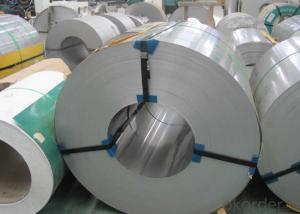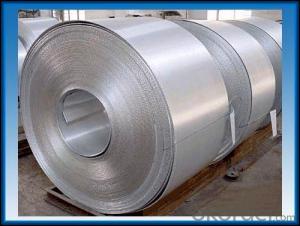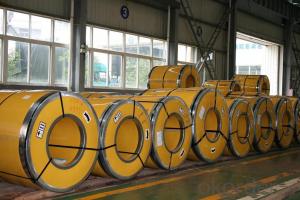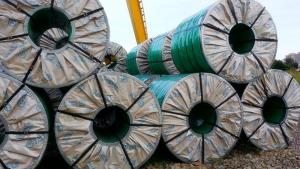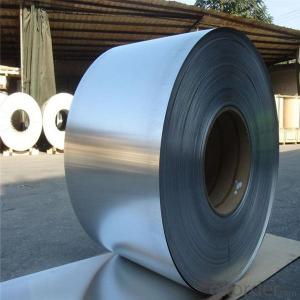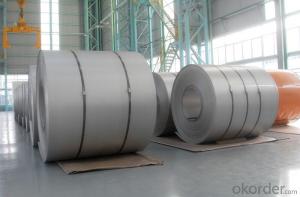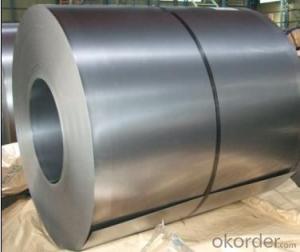430 SERIOUS HOT ROLLED STAINLESS STEEL COILS/SHEETS
- Loading Port:
- Guangzhou
- Payment Terms:
- TT OR LC
- Min Order Qty:
- 100 m.t.
- Supply Capability:
- 20000 m.t./month
OKorder Service Pledge
OKorder Financial Service
You Might Also Like
Quick Details
| Grade: | 400 Series | Standard: | JIS,AISI,ASTM,GB,DIN,EN | Thickness: | 0.21-3.0mm |
| Width: | 345-550mm | Place of Origin: | Guangdong China (Mainland) | Model Number: | 430 |
| Technique: | Hot Rolled | Application: | Kitchenware, decoration,plate , kitchenware , tableware , hardware, da | Certification: | ISO |
Packaging & Delivery
| Packaging Detail: | wooden pallet |
| Delivery Detail: | 30 days after receiving deposit |
Specifications
stainless steel coil
1)Surface:No.1
2)Thickness:2.4-4.0mm
3)Width:345-550mm
With advanced equipment and high technique , we specialize in manufacturing hot rolled stainless coils and cold rolled stainless coils of 201 ,202 ,304 . The hot rolled coils thickness is in range of 2.4mm -- 4.0mm , width of 345 to 555mm . The cold rolled coils thickness is in range of 0.23mm --3.0mm ,width of 345 to 55o mm. We supply a vast variety of qualified products in various specifications .Our products are widely applied in plate , kitchenware , tableware , hardware, daily products , decorative pipe and tube, hinge , etc. Our annual output exceeds 200,000 MT per year.
We adhere to the aim of “ High Quality and High Efficiency can win customer Satisfaction .” Quality is our sincerest respect offered to our customers all over the world , and it is the most important factor for us to win our customers’ hearts and establish
the long-term business relationships with our customers .
We hope to settle longlasting and honest cooperation with you. We will try our best to supply the best quality and price products to you. Developing together with our customers is our final faith.
Contact us !
Product Description
1)Chemical composition
C | Si | Mn | P | S | Cr | |
0.12 | 1.00 | 1.00 | 0.04 | 0.030 | 16-18 | |
0.12 | 1.00 | 1.00 | 0.04 | 0.030 | 16-18 |
- Q: Can stainless steel strips be used in the production of watches?
- Certainly, watches can indeed be produced using stainless steel strips. Stainless steel is widely chosen as a material for watch cases, bands, and other elements due to its resistance to corrosion, durability, and appealing aesthetics. It is possible to precisely cut and shape the strips to fashion various parts of the watch, such as cases, bezels, bracelets, and clasps. The use of stainless steel strips contributes to an elegant and refined appearance, making them suitable for both traditional and contemporary watch designs. Moreover, stainless steel is renowned for its robustness and long-lasting nature, guaranteeing that watches crafted with these strips will endure daily wear and tear.
- Q: How do stainless steel strips resist heat?
- Stainless steel strips resist heat due to the presence of chromium in their composition, which forms a protective oxide layer on the surface. This oxide layer acts as a barrier, preventing heat from penetrating the metal and providing excellent resistance to high temperatures.
- Q: Can stainless steel strips be used in heat exchangers?
- Yes, stainless steel strips can be used in heat exchangers. Stainless steel is a common material used in heat exchangers due to its excellent corrosion resistance, high heat transfer efficiency, and ability to withstand high temperatures. Stainless steel strips offer flexibility in design and can be easily formed into various shapes, making them suitable for heat exchanger applications.
- Q: Can stainless steel strips be used in water distribution systems?
- Yes, stainless steel strips can be used in water distribution systems. Stainless steel is highly resistant to corrosion and can withstand the harsh conditions and chemicals commonly found in water distribution systems. It is a durable and reliable material choice for ensuring the longevity and safety of water infrastructure.
- Q: Can stainless steel strips be used in the oil and gas industry?
- Absolutely! The oil and gas industry can indeed benefit from the utilization of stainless steel strips. Renowned for their resistance against corrosion, impressive strength, and long-lasting nature, stainless steel strips prove to be a fantastic choice for a multitude of applications within this sector. The fabrication of pipelines, storage tanks, heat exchangers, and other vital equipment utilized in the processes of oil and gas exploration, production, and refining often relies on stainless steel strips. Given the presence of corrosive substances like sulfur compounds and saltwater, the ability of stainless steel strips to endure such harsh environments while maintaining their structural integrity is of utmost importance. By doing so, they guarantee the safety and dependability of the equipment employed within this industry.
- Q: Are stainless steel strips suitable for decorative etching?
- Yes, stainless steel strips are suitable for decorative etching. Stainless steel is a versatile material that can be etched and engraved with intricate designs and patterns. It has a smooth and polished surface which makes it ideal for creating detailed and visually appealing decorative etchings. Additionally, stainless steel is highly durable and resistant to corrosion, ensuring that the etched designs will remain intact for a long time. This makes stainless steel strips a popular choice for various decorative applications such as signage, jewelry, art pieces, and architectural elements.
- Q: Can 111 stainless steel strips be coated with anti-corrosion paints?
- Yes, 111 stainless steel strips can be coated with anti-corrosion paints. Stainless steel is known for its corrosion resistance, but in certain environments or applications, additional protection may be required. Anti-corrosion paints are designed to provide an extra layer of protection against corrosion by creating a barrier between the steel surface and the surrounding environment. These paints can help prevent rusting, staining, and other forms of corrosion on stainless steel. It is important to ensure that the chosen paint is compatible with stainless steel and follows proper application procedures to achieve optimal results.
- Q: What are the standard coil sizes for stainless steel strips?
- The standard coil sizes for stainless steel strips typically range from 0.25 inches to 12 inches in width and 0.020 inches to 0.125 inches in thickness. However, these sizes can vary depending on the specific manufacturer and customer requirements.
- Q: The difference between stainless steel and cold rolled steel strip
- Stainless steel: the surface appearance and the possibility of the use of various good corrosion resistance than ordinary steel, durable good corrosion resistance and high strength, so the possibility of using large sheet of high temperature oxidation resistant and high strength, it can fire resistant temperature processing, plastic processing is easy because without surface treatment, so simple, maintenance is simple and clean, bright and clean a high degree of good welding performance.
- Q: Can stainless steel strips be used in the automotive parts industry?
- Absolutely, the automotive parts industry can definitely make use of stainless steel strips. Stainless steel is an incredibly versatile and durable material that offers a wide array of benefits for automotive applications. Its corrosion-resistant nature is of utmost importance in an industry where exposure to varying weather conditions and road salts can lead to rust and deterioration. Furthermore, stainless steel strips possess exceptional strength and impact resistance, making them ideal for structural elements such as chassis and body panels. Moreover, stainless steel strips can be easily shaped, welded, and machined, allowing for customization and seamless integration into diverse automotive parts and assemblies. Thanks to these advantageous characteristics, stainless steel strips are frequently employed in the production of exhaust systems, trim, brackets, fasteners, and various other automotive components.
Send your message to us
430 SERIOUS HOT ROLLED STAINLESS STEEL COILS/SHEETS
- Loading Port:
- Guangzhou
- Payment Terms:
- TT OR LC
- Min Order Qty:
- 100 m.t.
- Supply Capability:
- 20000 m.t./month
OKorder Service Pledge
OKorder Financial Service
Similar products
Hot products
Hot Searches
Related keywords
